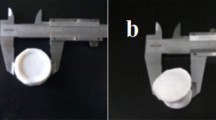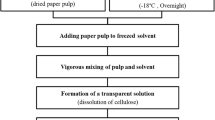Abstract
Superhydrophobic cotton cellulose (CC) aerogel was prepared from budget cotton with huge output. CC aerogels were synthesized by using commercial cotton extract as a precursor through the nano-self-assembly process, CO2 supercritical drying process, and vapor deposition. Typical, uniform hydrophobic CC aerogel structure can be confirmed by several characterization techniques. Maximum specific surface areas before and after modification are 213.80 m2·g−1 and 184.33 m2·g−1 with average pore sizes at 14.01 nm and 32.56 nm. The water contact angle is up to 153°, showing its superhydrophobic property. The maximum adsorption efficiency can be up to 16.0 g·g−1, which exhibits excellent cycling property after 5 adsorption tests. The oil absorption mechanism of the superhydrophobic CC aerogels is investigated in detail as well. This superhydrophobic CC aerogel has excellent adsorption performance and simple, rapid, effective oil contamination treatment which has promising applications in the field of oil adsorption and water remediation in oil adsorption.
Similar content being viewed by others
References
Wang B, Liang W, Guo Z, et al. Biomimetic Super-lyophobic and Super-lyophilic Materials Applied for Oil/Water Separation: A New Strategy Beyond Nature[J]. Chemical Society Reviews, 2014, 44(1): 336–361
Hazen TC, Dubinsky EA, DeSantis TZ, et al. Deep-Sea Oil Plume Enriches Indigenous Oil-degrading Bacteria[J]. Science, 2010, 330(6001): 204–208
Peterson CH, Rice SD, Short JW, et al. Long-term Ecosystem Response to the Exxon Valdez Oil Spill[J]. Science, 2003, 302(5653): 2 082–2 086
Hansen BH, Altin D, Olsen AJ, et al. Acute Toxicity of Naturally and Chemically Dispersed Oil on the Filter-feeding Copepod Calanus Finmarchicus[J]. Ecotoxicol Environ. Saf., 2012, 86: 38–46
Atlas RM, Hazen TC. Oil Biodegradation and Bioremediation: A Tale of the Two Worst Spills in U.S. History[J]. Environ Sci. Technol., 2011, 45(16): 6 709–6 715
Solevic T, Novakovic M, Ilic M, et al. Investigation of the Bioremediation Potential of Aerobic Zymogenous Microorganisms in Soil for Crude Oil Biodegradation[J]. Journal of the Serbian Chemical Society, 2011, 76(3): 425–438
Unyaphan S, Tarnpradab T, Takahashi F, et al. Effect of Emulsified Absorbent for Tar Removal in Biomass Gasification Process[J]. Biofuels, 2016, 7(3): 233–243
Shah MS, Tsapatsis M, Siepmann JI, et al. Hydrogen Sulfide Capture: From Absorption in Polar Liquids to Oxide, Zeolite, and Metal-Organic Framework Adsorbents and Membranes[J]. Chemical Reviews, 2017, 117(14): 9 755–9 803
Chu ZL, Feng YJ, Seeger S. Oil/Water Separation with Selective Superantiwetting/Superwetting Surface Materials[J]. Angewandte Chemie (International Ed.), 2015, 54(8): 2 328–2 338
Shakeri H, Arshadi M, Salvacion J, et al. Removal of BTEX by using a Surfactant-Bio Originated Composite[J]. Journal of colloid and interface Science, 2016, 466: 186–197
Zadaka-Amir D, Bleiman N, Mishael YG. Sepiolite as an Effective Natural Porous Adsorbent for Surface Oil-spill[J]. Microporous and Mesoporous Materials, 2013, 169: 153–159
Xu J, Chen L, Geng T, et al. Spherical Polymer Brushes Bearing Imidazole Groups as Novel Nickel Remover for Crude Oil[J]. Fuel, 2018, 226: 47–53
Lin BL, Cui S, Liu XY, et al. Preparation and Adsorption Property of Phenyltriethoxysilane Modified SiO2 Aerogel[J]. Journal of Wuhan University of Technology-Materials Science Edition, 2013, 28(5): 916–920
Zhao YF, Zhong K, Liu W, et al. Preparation and Oil Adsorption Properties of Hydrophobic Microcrystalline Cellulose Aerogel[J]. Cellulose, 2020, 27(13): 7 663–7 675
Loow Y, New EK, Yang GH, et al. Potential Use of Deep Eutectic Solvents to Facilitate Lignocellulosic Biomass Utilization and Conversion[J]. Cellulose, 2017, 24(9): 3 591–3 618
Gu XL, Luo GZ, Zhang RZ, et al. Effects of Silica Aerogel Content on Microstructural and Mechanical Properties of Poly (methyl methacrylate)/Silica Aerogel Dual-scale Cellular Foams Processed in Supercritical Carbon Dioxide[J]. Journal of Wuhan University of Technology-Materials Science Edition, 2016, 31(4): 750–756
Yuan DS, Zhang T, Guo Q, et al. Recyclable Biomass Carbon@SiO2@MnO2 Aerogel with Hierarchical Structures for Fast and Selective Oil-water Separation[J]. Chemical Engineering Journal, 2018, 351: 622–630
Feng JD, Nguyen S T, Fan Z, et al. Advanced Fabrication and Oil Absorption Properties of Super-hydrophobic Recycled Cellulose Aerogels[J]. Chemical Engineering Journal, 2015, 270: 168–175
Fan PD, Yuan YL, Ren JK, et al. Facile and Green Fabrication of Cellulosed based Aerogels for Lampblack Filtration from Waste Newspaper[J]. Carbohydrate Polymers, 2017, 162: 108–114
Cui S, Wang X, Zhang X, et al. Preparation of Magnetic MnFe2O4-Cellulose Aerogel Composite and Its Kinetics and Thermodynamics of Cu(II) Adsorption[J]. Cellulose, 2018, 25(1): 735–751
Wang X, Jiang SJ, Cui S, et al. Magnetic-controlled Aerogels from Carboxylated Cellulose and MnFe2O4 as a Novel Adsorbent for Removal of Cu(II)[J]. Cellulose, 2019, 26(8): 5 051–5 063
Mulyadi A, Zhang Z, Deng YL. Fluorine-Free Oil Absorbents Made from Cellulose Nanofibril Aerogels[J]. ACS Applied Materials & Interfaces, 2016, 8(4): 2 732–2 740
Rafieian F, Hosseini M, Jonoobi M, et al. Development of Hydrophobic Nanocellulose-based Aerogel Via Chemical Vapor Deposition for Oil Separation for Water Treatment[J]. Cellulose (London), 2018, 25(8): 4 695–4 710
Sun FF, Liu W, Dong ZX, et al. Underwater Superoleophobicity Cellulose Nanofibril Aerogel through Regioselective Sulfonation for Oil/Water Separation[J]. Chemical Engineering Journal (Lausanne, Switzerland: 1996), 2017, 330: 774–782
Yang X, Cranston ED. Chemically Cross-Linked Cellulose Nanocrystal Aerogels with Shape Recovery and Superabsorbent Properties[J]. Chemistry of Materials, 2014, 26(20): 6 016–6 025
Wang JT, Wang HF. Facile Synthesis of Flexible Mesoporous Aerogel with Superhydrophobicity for Efficient Removal of Layered and Emulsified Oil from Water[J]. Journal of Colloid and Interface Science, 2018, 530: 372–382
Author information
Authors and Affiliations
Corresponding author
Additional information
Funded by the Key Research and Development Project of Jiangsu Province (Nos.BE2019734, BE2017151, and BE2016171), the Program of Science and Technology of Suqian City (Nos. M201704, H201801, and H201803), the National Natural Science Foundation of China (Nos.51702156 and 81471183), the Program for Changjiang Scholars and Innovative Research Team in University of Ministry of Education of China (IRT_15R35), the Priority Academic Program Development of Jiangsu Higher Education Institutions, and the Brand Major Program Development of Jiangsu Higher Education Institutions (PPZY2015B128)
Rights and permissions
About this article
Cite this article
Zhao, Y., Peng, C., Cui, S. et al. Microstructure Characterization and Oil Absorption Performance of Superhydrophobic Cotton Cellulose Aerogel. J. Wuhan Univ. Technol.-Mat. Sci. Edit. 36, 538–545 (2021). https://doi.org/10.1007/s11595-021-2442-6
Received:
Accepted:
Published:
Issue Date:
DOI: https://doi.org/10.1007/s11595-021-2442-6




